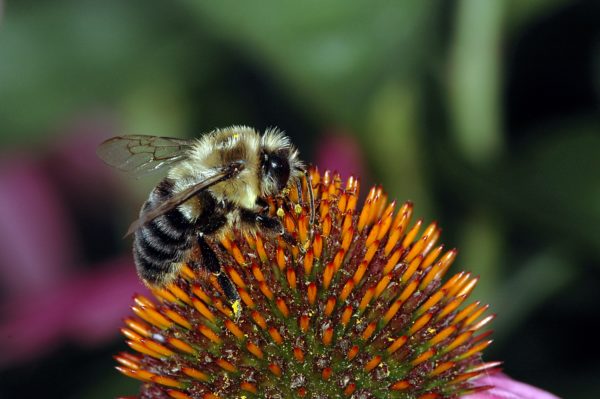“They paved paradise, put up a parking lot.” Written and sung by Joni Mitchell in the 1970s, those lyrics still hold true today as pavement and concrete structures squeeze out Toronto’s native bumblebees, say York University researchers in a new study published March 21.
The research found areas of the city with the most pavement, roads and concrete, and the highest density of buildings, had the fewest bumblebee colonies.
Corresponding author Professor Amro Zayed of the Faculty of Science, along with Associate Professor Sheila Colla of the Faculty of Environmental and Urban Change and a team of researchers, set out to examine how an urban environment can enhance the health and abundance of pollinators, such as the Common Eastern Bumblebee – Bombus impatiens.
“We used genetic techniques to fingerprint bumblebee workers and group them into families and nests, then used triangulation by dividing the city into 270 grid cells to determine where each nest is within Toronto, and how far worker bees had to go from their nest to forage for food,” says Zayed.

Specifically, they looked at landscape, population demography and income in Toronto to determine which features improved habitat quality by noting which areas had the most nests and bees, and the shortest distance to food. Foraging too far away can affect the lifespan of bumblebee workers and the fitness of colonies.
The researchers found bumblebee foraging distance increased and the number of bees in each colony decreased in areas with a higher density of buildings, roads, paved surfaces, bare ground, and humans. But what surprised them, was that the relative density of houses within each grid cell was associated with shorter foraging distances, compared to areas with high density multi-level buildings.
“The type of urbanization seems to matter. If there are no city parks or watershed forests, those urban areas with a higher density of single or multiple family houses, that would typically have front and backyards, seem to provide better foraging opportunities for bumblebees,” says Colla. “It’s increasingly important to design cities in a manner that sustains and enhances biodiversity and ecosystem services.”
While urbanization had a clear negative effect on both colony density and foraging distance of worker bees, functional (not cosmetic), green space was generally associated with higher quality habitats for bumblebees.
In addition, the researchers found no evidence of a “luxury effect” – the idea that wealthier neighbourhoods are better for bee habitats.
Zayed notes there are several ways Toronto can become more bee friendly. The key, he says, is to create diverse green spaces.
“By converting boring green spaces, such as grass lawns, into functional green spaces like meadows and pollinator gardens, city dwellers can provide ideal bee habitats,” says Zayed. “Cities can also convert some of the concrete to green spaces, but parks and forests are also beneficial to pollinators.”
Bumblebees like a variety of plant species, many of which can easily be planted in front yards and backyards, including black-eyed Susan, Canadian goldenrod, New England aster, purple coneflower, willow and various fruit trees and shrubs. These are good for other pollinators as well.
Cities can also seek pollinator-friendly certifications through programs such as Bee City Canada by pledging to implement actions aimed at protecting pollinators.
The paper, Bees in the six: Determinants of bumblebee habitat quality in urban landscapes, was published in the journal Ecology and Evolution.


